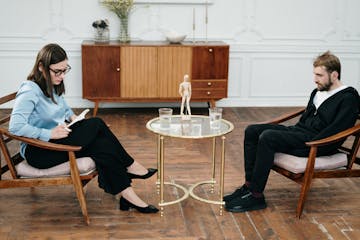Creativity is a fascinating process that involves the generation of original and significant ideas. Creativity has often been associated with emotional suffering, specifically depression. The relationship between creativity and depression has been the subject of study and interest in psychology and psychiatry, since there seems to be a complex connection between both states. In this article, we will explore this relationship in detail and analyze how depression can influence creativity and vice versa.
Creativity as an emotional escape
For many creative people, artistic expression can be a refuge from the feelings of sadness, hopelessness or emptiness that characterize depression. Creativity allows them to channel their emotions constructively, transforming pain into something tangible and meaningful. Art-making can serve as a form of personal therapy, helping individuals make sense of their experiences and find solace in their art.
On the other hand, depression can bring a unique sensitivity to people. creative, allowing them to connect more deeply with human emotions and experiences. This intense emotional connection can be a source of inspiration for creativity, as many artistic works are based on the exploration of the darkest and most complex aspects of the human psyche.
The myth of the tortured artist
The concept of the "tortured artist" or "tormented genius" has been a common narrative in popular culture, suggesting that creativity is intrinsically linked to emotional suffering. Many famous artists, such as Vincent van Gogh, Sylvia Plath and Kurt Cobain, have struggled with depression and other mental illnesses, which has helped perpetuate this romantic image of the artist as someone who suffers to create.
However, it is important to note that not all creative people experience depression, and that the connection between creativity and suffering is not as direct as is often made out. Creativity can manifest itself in various ways and is not necessarily linked to emotional pain. In fact, many people find creativity a source of joy, satisfaction, and emotional well-being.
The cycle of depression and creativity
The relationship between depression and creativity can be bidirectional, that is, creativity can be affected by depression, but depression can also be influenced by creativity. This complex cycle can vary in intensity and manifestation in each individual, but generally involves the following aspects:
Impact of depression on creativity
Depression can affect a person's ability to to concentrate, find motivation, or enjoy activities that used to bring you pleasure. In the case of artists and creatives, this can translate into a creative block, making it difficult to generate new ideas or complete artistic projects. The lack of energy, excessive self-criticism, and low self-esteem associated with depression can also inhibit creativity and artistic expression.
In addition, depression can distort one's perception of oneself and the world, leading to can influence the way a person channels their emotions through their art. Authenticity and creative originality can be compromised when depression clouds one's judgment and self-evaluation.
The influence of creativity on depression
On the other hand, creativity can play an important role in managing and overcoming depression. Artistic creation can serve as an emotional outlet, allowing people to channel their feelings of sadness, anxiety, or hopelessness in productive and meaningful ways. Expression through art can provide a means of non-verbal communication to express complex emotions that are difficult to articulate in words.
In addition, creativity can give people a sense of purpose and meaning, helping them to finding meaning in the midst of suffering and emotional distress. The ability to create something new and unique can be a source of empowerment and self-affirmation for those struggling with depression.
Addressing the relationship between creativity and depression
For creative people who experience depression, it is crucial to establish effective strategies to manage and address both aspects of your life. Some recommendations that may be helpful include:
Seek professional support
Psychological therapy can be invaluable for creative people dealing with depression. A mental health therapist can help explore the links between creativity and depression, as well as develop tools to manage emotional distress and encourage creative expression in healthy ways.
Practice self-care
Self-care is essential to maintaining a healthy balance between creativity and mental health. Establishing regular routines of sleep, exercise, healthy eating, and rest can help improve mood and energy, which in turn can support creativity and artistic expression.
Explore new forms of expression
It is important to allow yourself to experiment with different forms of creative expression, even those that may be different from the usual ones. Artistic exploration can open up new perspectives and approaches, allowing creative people to expand their creative repertoire and discover new ways to channel their emotions.
Main Takeaways
In summary, the relationship between Creativity and depression is complex and multifaceted. While depression can affect a person's creativity, creativity can also influence how depression is experienced and managed. It is essential to recognize the interaction between these two aspects and seek balance and well-being in both to foster healthy and sustainable creative development.
By understanding and properly addressing the relationship between creativity and depression, creative people can harness your artistic and emotional potential in a meaningful way, finding creative expression a powerful tool for self-expression, emotional healing and personal growth.
Author: Psicólogo José Álvarez


